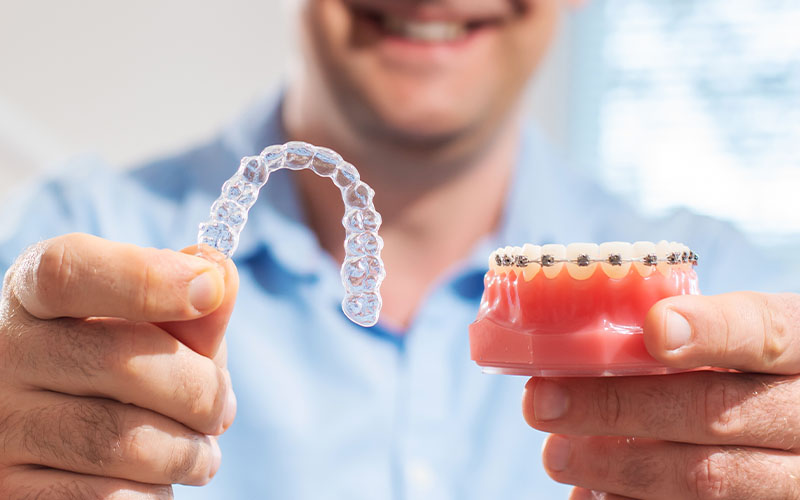Introduction
When it comes to orthodontic treatment, two popular options that often come up in conversations are Invisalign® and braces. These treatments can help address dental issues such as misalignment, overcrowding, and bite problems, but they have distinct differences. Choosing between Invisalign® and braces requires considering various factors, including effectiveness, treatment duration, aesthetics, comfort, maintenance, cost, and candidacy. In this article, we will delve into these aspects to help you make an informed decision.
Understanding Invisalign®
Invisalign® is a modern orthodontic treatment that utilizes a series of clear, removable aligners to gradually move teeth into their desired positions. These aligners are custom-made using 3D imaging technology, making them virtually invisible when worn. Invisalign® aligners offer a discreet and convenient alternative to traditional braces.
Understanding Braces
Braces, on the other hand, consist of metal or ceramic brackets that are bonded to the teeth. These brackets are connected by wires and bands, which apply gentle pressure to guide the teeth into proper alignment. Braces have been a trusted and effective method for correcting dental issues for many years.
Comparison between Invisalign® and Braces
- Factors to Consider
When choosing between Invisalign® and braces, several factors should be taken into account. These include the severity of your dental issues, your lifestyle, personal preferences, and the recommendation of your orthodontist.
- Effectiveness
Both Invisalign® and braces are highly effective in treating a wide range of orthodontic concerns. However, certain complex cases may be better suited for braces due to their ability to exert greater control over tooth movement.
- Treatment Duration
The treatment duration for Invisalign® and braces can vary depending on the complexity of the case. Generally, Invisalign® treatment may be shorter than traditional braces treatment, but it ultimately depends on individual circumstances.
- Aesthetics
Invisalign® aligners are transparent and barely noticeable, making them a popular choice for individuals who wish to undergo orthodontic treatment discreetly. Braces, on the other hand, are more noticeable but can be customized with different colors and styles for a personalized touch.
- Comfort
Invisalign® aligners are made from smooth plastic, reducing the chances of irritation or discomfort typically associated with braces. Braces may cause some initial discomfort due to the presence of brackets and wires, but patients typically adjust to them over time.
- Maintenance and Care
Invisalign® aligners can be removed during meals and when brushing and flossing, allowing for easy maintenance of oral hygiene. Braces require extra attention during oral care routines, as food particles can get trapped in the brackets and wires.
- Cost
The cost of Invisalign® and braces can vary depending on the complexity of the case and the duration of treatment. In general, braces tend to be more cost-effective compared to Invisalign®, but it’s essential to consult with your orthodontist to determine the specific costs involved.
- Candidacy
Not everyone is a suitable candidate for Invisalign® or braces. Complex cases or severe misalignments may require braces, while Invisalign® is often a viable option for mild to moderate dental issues. Your orthodontist will evaluate your condition and recommend the most suitable treatment.
Choosing Invisalign®
If you value aesthetics and wish for a discreet treatment option, Invisalign® might be the right choice for you. It offers the flexibility of removable aligners, allowing you to enjoy your favorite foods without restrictions. Invisalign® also provides convenience during oral hygiene routines, enabling you to maintain excellent dental health throughout the treatment.
Choosing Braces
Braces are a time-tested and highly effective treatment for a variety of orthodontic problems. If your case is more complex or requires precise control over tooth movement, braces may be the recommended option. Braces also allow for customization with different colors and can provide a unique and personalized look.
Conclusion
In the decision-making process of choosing between Invisalign® and braces, it’s crucial to consider your specific dental needs, lifestyle, treatment preferences, and the advice of your orthodontist. Both Invisalign® and braces have their advantages and are capable of delivering excellent results. Consulting with a professional will help you determine the most suitable treatment option for your individual case.
FAQs
- Can I switch from braces to Invisalign® midway through my treatment?
While it is possible to switch from braces to Invisalign® in some cases, it ultimately depends on your specific situation. Consulting with your orthodontist will provide the best guidance.
- Will wearing braces or Invisalign® affect my speech?
Initially, you may experience slight changes in your speech with either treatment, but most individuals adjust within a short period. Any speech issues are typically temporary and resolve as you get accustomed to the appliances.
- Can I eat all types of food while wearing Invisalign® aligners?
Invisalign® aligners should be removed when eating, allowing you to enjoy a wide variety of foods without restrictions. This is one of the advantages of Invisalign® compared to braces.
- Are there age restrictions for Invisalign® or braces?
Both Invisalign® and braces can be used by individuals of various ages. They are effective for teenagers, adults, and even older individuals, depending on their dental needs.
- How often do I need to visit my orthodontist during treatment?
Regular visits to your orthodontist are necessary to monitor your progress and make any adjustments as needed. The frequency of visits will be determined by your orthodontist based on your treatment plan.
If you’re looking for reliable and professional orthodontic treatment in Edmonton, look no further than Lotus Dental Wellness. Our team of experienced orthodontists is dedicated to providing exceptional care and helping you achieve a healthy, beautiful smile. We offer a range of orthodontic options, including Invisalign® and braces, tailored to your specific needs. With state-of-the-art facilities and a patient-centered approach, we ensure your comfort and satisfaction throughout your orthodontic journey. Take the first step towards a confident smile by contacting Lotus Dental Wellness today and scheduling your consultation.
